Those of us who love dogs find the prospect of bringing home a new canine family member intoxicating and exhilarating. Well-planned in advance or not, the adoption of a new dog likely triggers a rush of oxytocin unparalleled by all but a few other high-end life experiences.
That said, while some spur-of-the-moment adoptions can and do turn into successful relationships, when possible, we highly recommend that your next dog adoption be well thought out in advance, and you select your new dog carefully, to maximize the likelihood that you will be able to provide a lifelong loving home for the fortunate canine who joins your family.
THINK IT THROUGH
The process of adopting a dog can be daunting. We encourage you to do some pre-planning before you start looking for the newest member of your family, to increase the chances that you will find an ideal lifetime companion.
If you are single and living alone, you are free to consider only your own needs and wants; the process becomes considerably more complex if you have family or housemates. In either case, before you begin your search in earnest, it behooves you to think about your prerequisites and preferences, including:
• Family/roommate buy-in. Is everyone in the household on board with getting a dog (or another dog)? If not, work through all the reservations before you proceed any further. It doesn’t benefit the dog to bring her into a home where there will be simmering resentment or outright conflict over her presence.
• Breed and source. Do you already have your mind set on a specific breed or breed-type? If so, does everyone in the family or household feel comfortable with your choice? Have you researched the breed thoroughly so you understand its behavior propensities and common medical issues?
If you are looking for a particular breed or type, you might consider adopting from a breed rescue group, getting pre-approved and putting yourself on a waiting list at your local shelters, or purchasing from a reputable breeder. Private-party adoptions are also a reasonable option – a friend or co-worker who needs to rehome a canine companion, or even, carefully, a private adoption from a classified ad, or Craigslist. No pet-store puppies, ever, please. (For more about where to look for your next dog, see “Adopt or Shop,” WDJ August 2020.)
• Size. If you don’t already have a breed in mind, does size matter? If so, what size dog are you considering – toy, small, medium, large, or giant?
Be aware that toy and giant breeds are at greater risk for significant medical problems. In general, the giant breeds tend to have short life spans while the smaller breeds tend to live longer. A recent analysis of veterinary records revealed that dogs under 20 pounds had an average lifespan of 11 years, with some smaller dogs living as long as 14 years or more, while those over 90 pounds typically lived for an average of only eight years. Small dogs may be a greater tripping risk – but they are more portable! – while large and giant breeds may be more likely to knock you over (or your senior grandparent).
• Age. Puppies are undeniably adorable. On the plus side, starting with a baby dog means you can have a huge influence on her development and know that her world has been force-free from very early on. Still, that’s not a guarantee that she will turn out to be the perfect dog, especially if she wasn’t well socialized before you adopted her. (Despite what you may have heard, an eight-week-old puppy is not a “blank slate.”) And they are a lot of work.
As we recently contemplated the adoption of a 3-month-old Australian Cattle Dog-mix, my husband and I realized that we don’t want to adopt a puppy. They are a lot of work!
In contrast, adult dogs are more likely to be a “what you see is what you get” proposition – although they can deliver behavioral surprises too, as they adjust to their new life with you. They are past the “needle-sharp puppy teeth” stage, thus less likely to shred your flesh (and your possessions) with puppy mouthing. And while some adults still may enjoy chewing, there’s a good chance they will be less destructive (barring anxiety-related behaviors) and are more likely to already be house-trained (or easily house-trained).
On the other hand, it’s also possible that they may come to you with some already-well-established behavior challenges…
• Coat. Are you thinking short or long coat? Does it matter to you? It matters a lot to some people.
First, consider grooming. Is someone going to be happily responsible for brushing that long Afghan Hound, Collie, or Pomeranian fur on a regular basis – at least once a week, and maybe more? Will you happily bear the cost of routine trips to the groomer for that Poodle or Doodle clip? Will your Roomba handle the carpet of long white Great Pyrenees fur that covers your rug?
You’re not off the hook with short-coated dogs either – those prickly Labrador Retriever hairs are great at infiltrating the fabric of your furniture (or business suit) and can be a bear to get out! Of course, there’s always the Mexican hairless dog… the Xoloitzcuintli (pronounced “show-low-eats-QUEENT-lee”).
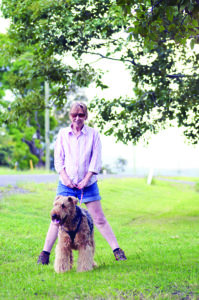
• Dog-keeping details. Which family members will be responsible for which dog-related chores: feeding, clean-up, walks, grooming, trips to the vet, training? Where will the dog sleep? Is she allowed on the furniture? Who will be your vet, groomer, pet sitter, dog walker? There is an endless array of minutiae that comes with sharing your life with a dog; the more of the details you work out in advance, the better!
SELECTING YOUR DOG
Okay: You’ve given all of the previous prerequisites and preferences some consideration. You’ve read the “Adopt or Shop” article in the August issue of WDJ, so you know where you are going to look for your next dog. It’s time to go meet some prospects!
When my husband and I both worked at animal shelters, selecting our next dog was easy. We never actually set out to look for one; instead, while we met dozens of dogs every week, sooner or later a dog would enter the shelter that one or the other of us would have a near-instant connection to. Our “love at first sight” moments would then be enhanced by the opportunity to get to know the dog better over the next few days as he went through the intake process.
Since leaving shelter work, we’ve learned just how challenging it can be for most people to find the perfect dog! You go to the shelter or rescue meet-and-greet location, you see a dog that appeals to you, spend a few minutes with him, and the next thing you know you’re filling out adoption papers. You wouldn’t get married that way!
Today, it’s common for people to receive very little information about the dog they adopt. When we worked in shelters, we would get extensive information from owners who were surrendering their dogs. We generally had less information about stray dogs that our officers picked up, but at least we conducted behavior assessments (flawed as they may be) and kept notes on the dog’s behavior during her stay with us. Anything we learned about the dogs was passed on to the adopter.
In contrast, today it seems like few organizations have much information about their dogs other than “she came from a shelter in North Carolina.” They sometimes don’t even seem to know if the dog was owned or stray! When it’s time to adopt, you may have to rely entirely on your own observations and instincts about the dogs you meet – and purchasing from a breeder can be equally fraught with challenges.
Here are some suggestions to help you succeed in your adoption quest:
* Get help. If your adoption organization doesn’t provide skilled adoption counseling and you aren’t confident in your own abilities to make a good choice, consider taking a dog-savvy friend with you, or even paying a qualified force-free professional to help you with your search. The same holds true if you are purchasing from a breeder. Take someone with you, unless you are 100% confident that the breeder is ethical, knowledgeable, and well-qualified to you help you select your pup.
* Insist on meeting the dog in person. I am a professional dog trainer/behavior consultant and I wouldn’t even consider adopting a dog sight unseen. I don’t care what information or assurances the organization has given you, or how many videos of the dog you have watched – you don’t know who the dog is until you meet him.
I am appalled by the prevalence of internet adoptions happening these days with no actual meeting between dog and human until after the paperwork is signed and sealed and the dog is delivered halfway across the country. While it is fairly common practice for breeders to ship puppies across the country (or across oceans!) to buyers, sight unseen, I wouldn’t do it, no matter how great the breeder’s reputation.
* Know what you’re looking for (as described above) – and also know which qualities might be negotiable. Perhaps you’re looking for a female Border Collie and you go to the shelter and the most perfect male Australian Shepherd is there in the kennel, begging you to adopt him. Close enough? Maybe so!
It doesn’t necessarily even have to be that close. A husband/wife couple, clients of mine, were recently looking to adopt a small dog. They went to the shelter to meet a 20-pound terrier-mix they had seen on the website, but when they got there the dog was already adopted. They came home with a purebred Akita who is one of the nicest dogs I’ve met in a long time. They are quite thrilled with their new family member.

* Resist the pity party pup. It’s easy to feel sorry for the poor, scared dog huddled in the back corner of her kennel run. But you should know that if you adopt this dog there’s a very good chance you are looking at a significant behavior-modification project; it’s possible that this dog will have fear-behavior challenges for the rest of her life. Note: I am a dog behavior professional and I would not adopt such a dog!
Truth be told, most people want a behaviorally healthy dog they can take with them to the beach, to the office, to their child’s soccer game, on hikes, to family reunions, to dog training classes – and shy, frightened dogs may never be able to do those things. Adopt only if you enjoy the challenge of a behavior modification project and understand the possible long-term ramifications of adopting a fearful dog.
* Consider foster-to-adopt. More shelters and rescue groups now offer this as an option, both to give you a chance to evaluate the dog in a home setting and to free up shelter and foster home space for incoming dogs. Fostering can give you and the dog the opportunity to see if it is a good fit – and allows you to feel less guilty about returning the dog if it doesn’t work out. You hadn’t made a full commitment, and you are now able to provide the adoption agency with information that can help them make a better fit with another adopter.
* Conduct your own behavior assessment. It doesn’t have to be as extensive as the ones that some organizations utilize, but there are some basic things you can do to see how the dog responds and make adoption decisions accordingly.
A DO-IT-YOURSELF BEHAVIOR ASSESSMENT
Studies in recent years have found shelter assessments to be unreliable and non-predictive; behaviors seen in assessments are often not seen in the adoptive home after the dog leaves the shelter, and behaviors not seen in the assessment may appear after the dog is in a home. Even so, it helps to walk through a structured assessment, if only to extend the amount of time you spend with the dog before making a commitment.
I’m not suggesting you do an extensive assessment protocol, just try a few reasonably non-aversive things to see how the dog responds. If you’re headed out to assess a potential new family member, take this list with you and circle the appropriate letters for the behaviors you see. Having a rubric like this can help guide you to a smart decision.
Before you start, ask if the shelter or rescue group is comfortable with you performing an assessment, and share with them the protocol you intend to use.
1. Watch the dog. Before actually interacting with the dog, observe her from a distance. Is she:
[A] Comfortable and relaxed in her kennel or other housing? (This would be ideal.) [B] Pacing, stressed, and barking? [C] Charging at dogs and humans who pass? [D] Huddled in the back?Note that B, C, and D are red flags; however, some dogs who are stressed or fearful in the kennel are reasonably normal when in a less intimidating environment, so this doesn’t have to be a complete rule-out.
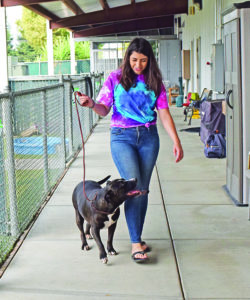
2. Walking on leash. Out of the kennel and on leash, does she:
[A] Walk happily with her handler? (This is ideal.)
[B] Pull hard on the leash and/or sniff? (This is your basic training project.) [C] Flail wildly or put on the brakes and refuse to move? (This represents a more significant training and/or behavior challenge.)3. Take her off leash. In a safely enclosed area, remove her leash. Does she:
[A] Happily greet and stay somewhat near humans? (This is ideal affiliative behavior.) [B] Cling desperately to humans? (This might be fear or separation-related behavior.) [C] Confidently explore the room with occasional check-ins with the humans? (This is nice, somewhat independent behavior.) [D] Confidently explore the room and ignore humans? (This might indicate a very independent dog, which can be challenging.) [E] Go wild and crazy, racing around the room non-stop with glee? (High-energy dogs can be a challenge.) [F] Pace back and forth, perhaps whining, never calming or settling down? (A stressed, anxious dog can be a significant behavior challenge – or could settle once out of the shelter environment.) [G] Cautiously explore the room? (She may lack confidence and need some behavior modification.) [H] Hide in a corner and refuse to move? (This is a very fearful dog who will need extensive behavior modification.)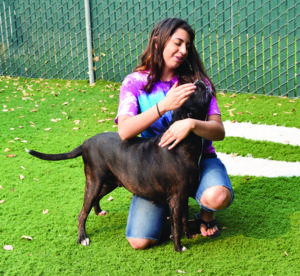
4. How is she with handling? With the leash back on, do some general handling: Pet her all over, touch her paws, look in her ears, look at her teeth. (Stop at any time if she appears uncomfortable or resistant to a degree that is unsafe.) Does she:
[A] Enjoy your touch, warm and wiggling and asking for more? (Best.) [B] Tolerate your touch but not really enjoy it or invite more interaction? (This is acceptable if you aren’t looking for a touchy-feely snuggle-dog.) [C] Move away from you? (If she’s clearly not comfortable with handling, she may be a behavior-modification project.) [D] Freeze, give you a hard stare, growl, and/or snap? (These indicate significant behavior issues; do not adopt unless you are a behavior professional or very skilled and experienced dog owner looking for a project.)5. Check for any training. Ask the dog to sit, lie down, and shake – three behaviors that owners are most likely to have taught her. Then see if you can get her to do anything by luring with treats that you brought with you. Does she:
[A] Appear to have already have some training? (This is best.) [B] Easily perform new behaviors that you try to get her to do with a treat? (This is also great.) [C] Show interest in the treat but doesn’t understand what you are trying to get her to do? (This is acceptable; she may just need more time and patience to help her understand.) [D] Show no interest in the treat? (She may be too stressed to be interested in food – but her lack of interest in food may present a more significant training challenge.)6. Is she playful? Try offering the dog a variety of toys you have brought with you – a ball, a stuffed squeaky toy, a tug, a food-dispensing toy. Start with gentle play; you can intimidate some dogs if you play with them too much or too hard. Does she:
[A] Play with you happily and appropriately? (This is best.) [B] Play with you happily but gets too aroused and a little mouthy? (This is acceptable, but she will need management and training.) [C] Love to play with the toys but gets a little (or a lot) tense when you try to take the toy? (This indicates a tendency to guard her “stuff,” better known as resource-guarding; she will need management and training to improve this behavior.) [D] Declines to play at all? Avoids you or looks at you like you’ve lost your mind? (This is okay if you don’t mind a dog who doesn’t play, or you want to try to teach her to play; see “Let the Games Begin,” November 2014.)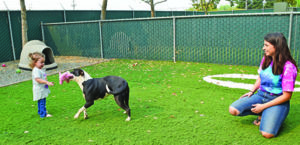
7. Kid considerations. If you have children you must have your potential dog meet them before finalizing the adoption. Some dogs who are perfectly wonderful with all of the above simply cannot live with children. For a dog to live safely with children she should adore them, not just tolerate them. When the dog sees your child or children, does she:
[A] Appear happy to approach and interact appropriately, as if she were saying, “Yay! Kids!”? (This is best.) [B] Appear happy to approach and interact, but is a little too excited? (She will need management and training.) [C] Appear to ignore or tolerate the presence of the child or children? (If you have kids, this is not acceptable; do not adopt this dog.) [D] Is she cautious, fearful, reactive or aggressive? (Do. Not. Adopt!)8. Do you have other dogs? Ideally, you will have brought along your home dog(s) so they can be introduced in a neutral environment. If not, if at this point you are still very interested in the dog, ask to have the dog put on hold so you can go home to get your home dog(s) for an introduction. Introduce them carefully, of course, and again, have a qualified dog training professional or dog-savvy friend present to help.
When the dogs see each other from across the room or yard, do they:
[A] Both appear reasonably calm and happy to approach and meet each other? (This is best.) [B] One appears more assertive, the other more appeasing? (This is also great, as long as the more assertive dog doesn’t come on too strong.) [C] Both appear happy to approach but are very excited? (This is acceptable, though you will need to manage their behavior with each other.) [D] Dogs ignore/avoid each other? (This is not a good choice; avoidance often turns into a significant behavior challenge.) [E] Either or both dogs show signs of tension: stiff body language, hard stares, growling, reactivity? (This is not a good choice.)9. Do you have other animals in your family? If you have other small or large companion animals (cats, pigs, birds, horses, etc.), ask if the dog has any history around those, and if there are any available on the premises where you are meeting the dog. With the dog on leash at a distance, observe her behavior. Does she:
[A] Watch calmly from a distance? (This is best.) [B] Watch with happy excitement from a distance? (This is okay, though she will need management and training.) [C] Become highly aroused and /or reactive, barking and lunging? (With excellent management and modification, this might be acceptable if you have large animals – but it’s not acceptable if you have small animals.) [D] Go into predator/stalking mode, or crouch, with a hard stare? (With excellent management and modification, this might be acceptable if you have large animals – but it’s not acceptable if you have small animals.)A CHALLENGING QUEST
It’s been eight years since my husband and I have been closely affiliated with a shelter. Two years ago, in the same year, we lost our last two shelter adoptees to old age and cancer.
Our current dogs are not shelter alumni; we were unable to find the dogs we wanted through any of our local shelters or rescue groups. After lengthy searches we adopted one from a rescue group in New York (we live in Maryland) and the other was privately adopted; he was being rehomed through Craigslist. Now we can better empathize with the struggles of dog lovers to find good candidates for their own families.
Even so, scarcity isn’t a good reason to be less than scrupulous in your assessments. Remember, you are making a commitment of thousands of dollars for food and veterinary care, and countless hours of time spent with your dog over at least the next decade or more. Take your time! Good luck with your search.
Author Pat Miller, CBCC-KA, CPDT‑KA, is WDJ’s Training Editor. She lives in Fairplay, Maryland, site of her Peaceable Paws training center. See page 24 for information about her books and courses.


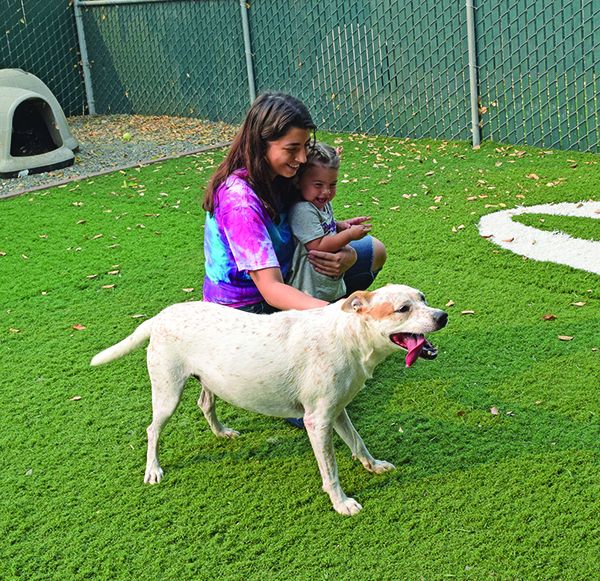




oPgwjlTxEcDn
Thanks for the information it’s very true the kids has to meet the dog before you finalize the adoption it’s very important.
I would love to get more information on evaluating dogs when it’s critical to choose a dog that behaves wonderfully with cats, and even occasional rescue raccoons, squirrels, birds…
We have adopted two rescues. Morty was left in a house and people moved out. He was GREAT. Scared of heavy rain and thunder. Didn’t like to be left alone. He lived two weeks shy of 10 and was put down from cancer. We got another rescue about a year later. Named her Sadie. I call her a Miami street dog. She was found wandering the streets of Miami. She loves people, does not like other dogs. She sits next to me on the couch and stares at me. I did not give her the “tests” you suggested, but everything worked out fine Thank you for a great article